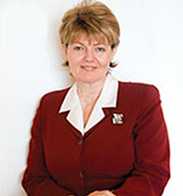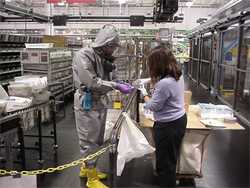Vision, Duty and Confidence Creates a No-miss Laboratory

CDC's Tanja Popovic, M.D., Ph.D
Few stories cast the laboratory scientist in a leading role. However, laboratorians across the nation led in the response to the intentional release of anthrax through the mail in 2001. This crisscross of highly prized experts was trained to be able to detect anthrax in lab specimens, with uncompromising precision, by CDC's Tanja Popovic, M.D., Ph.D.
In 2001, the laboratorian who detected the first case of inhalation anthrax in the United States since 1976 was trained by Popovic. "Phil Lee from the Florida Health Department laboratory called to tell us he had an anthrax case. This was incredible news. My word of confidence that Phil had it right was an important component of CDC's leadership to quickly send the CDC team to Florida, even without the final laboratory confirmation at CDC," Popovic said. "I spoke with him and was confident that he knew what he was doing."
Five years of intense work
That confidence stemmed, in part, from nearly five years of intense work and vision to get the United States laboratories prepared to respond to a bioterrorism attack using anthrax. "I view Brad Perkins [M.D.] as the key visionary who, in 1996, recognized CDC did not have the laboratory expertise it needed with anthrax. He asked me to put a lab together that could do work with anthrax and develop a standardized protocol that could be used throughout the country to identify this bug," she credits.
However, this accomplished scientist and physician who immigrated to the United States from Croatia with her husband and two young children in 1989, had mixed feelings initially about the new assignment. "Anthrax was not on the tip of everyone's tongue. Some wondered what I had done wrong to get this seemingly insignificant task. It was a dead end they thought. But when Brad explained what was at risk, he was so convincing. I saw his vision too," she said.
CDC leadership asked Popovic to create a state-of-the-art lab at CDC and then to teach what she knew to a network of laboratories across the nation. "This was about preparedness. We were building overall capacity for multiple agents, anthrax, brucellosis, tularemia," she explained. Popovic wanted to teach lab techniques that could be used for anthrax, but also could be used for other possible threats. "If you learn how to do PCR [polymerase chain reaction—a simple tool that can take a portion of DNA and copy it billions of time so it can be detected] for anthrax, you have that knowledge and it can be modified for other disease, in a suspicious situation or not—that way the overall level of public health laboratories is strengthened. That was the key."
Just six months before
 Popovic and her small team of experts completed training a national network of laboratorians just six months before the anthrax letters were mailed. The seasoned scientist brushes off questions of "what if" and concentrates on what did happen. "This did not come from luck. This came from the vision of some dedicated people to whom we all owe a lot.
Popovic and her small team of experts completed training a national network of laboratorians just six months before the anthrax letters were mailed. The seasoned scientist brushes off questions of "what if" and concentrates on what did happen. "This did not come from luck. This came from the vision of some dedicated people to whom we all owe a lot.
"We were ready. I was confident, very confident of our microbiology. I never doubted what we did and our conclusions. And we never missed. I never had to come back and say our lab got it wrong," she declared.
The stress was not in questioning what they were doing—the stress came from other places, like creating protocols "on the fly" for environmental sampling. "In the first days of the investigation, we settled on using moist swabs to collect the environmental samples in this event. At times we also brought the entire sample to CDC for example, an air vent filter," she said. Also stressful were the constant demands for information and the interruptions of the lab work they caused before the formal chain of communications was established.
We didn't go home for weeks
"We set up cots in our conference room and our team rotated between the lab and sleeping. For weeks, some of us went home only for a brief shower and change of clothes," she recalls. While some might lament the upheaval in their lives from the weeks of unrelenting demands, Popovic sees her work as a tribute to her nation, public health and CDC. "I had the opportunity to see what CDC does from a front row seat. The CDC laboratory community wanted to contribute to protecting this country, and we were really damn good."
From the moment her lab confirmed anthrax from a swab that was swept over the keyboard in the office where the first anthrax patient had worked, Popovic knew it was not a naturally occurring event. "This was intentional. We didn't know who, but we knew we needed to find the source. We needed to determine where the exposures occurred," she said.
Her work on anthrax did not conclude after the last specimen collected was tested. In the first year following the response, Popovic co-edited a special publication with 32 scientific papers on what the public health community did and learned.
However, her lasting lesson is the importance of vision and the willingness to invest for the future—to resist slipping into complacency. Popovic wishes more than anything to clear the path for scientists who do public health research. "We have obstacles that should be removed to make it easier for our scientists to do their work," she challenges. Popovic seems undaunted by the prospect of confronting these obstacles—not surprising from someone who took a "dead end" assignment not so long ago that, in turn, helped protect a nation.
- Page last reviewed: March 19, 2014
- Page last updated: March 19, 2014
- Content source:


 ShareCompartir
ShareCompartir